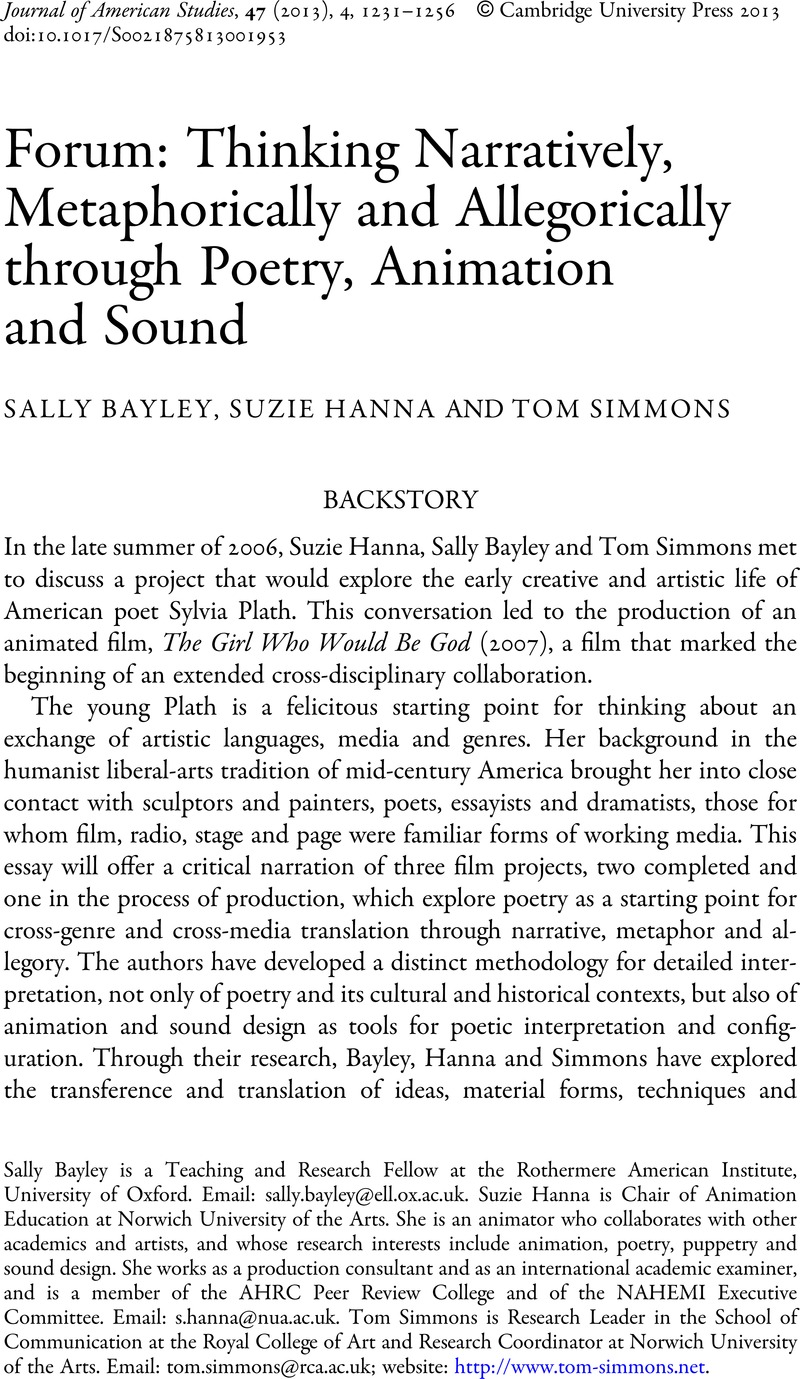No CrossRef data available.
Published online by Cambridge University Press: 29 October 2013

1 The Oxford English Dictionary defines metaphor in the first instance as: 1. A figure of speech in which a name or descriptive word or phrase is transferred to an object or action different from, but analogous to, that to which it is literally applicable; an instance of this, a metaphorical expression.
2 A supplementary document containing images from the three films can be viewed at http://dx.doi.org/S0021875813001953.
3 Bayley and Hanna, email conversation, 8 June 2013.
4 Ashworth, Joan, Textures of Reality International Animation Symposium (London: National Film Theatre Programme, Feb. 2004)Google Scholar.
5 Quoted in Connors, Kathleen and Bayley, Sally, eds., Eye Rhymes: Sylvia Plath's Art of the Visual (Oxford: Oxford University Press, 2007), 69Google Scholar.
6 Quoted in Connors and Bayley, 69.
7 Bayley and Hanna, email conversation, 29 May 2013.
8 Sylvia Plath: Collected Poems, ed. Hughes, Ted (London: Faber & Faber, 1981), 303Google Scholar.
9 Machosky, Brenda, ed., Thinking Allegory Otherwise (Stanford: Stanford University Press, 2010)Google Scholar.
10 Angus Fletcher, “Thinking Allegory,” in Machosky, 10.
11 We are indebted to Tom Simmons for reminding us of this essential structure of thought and representation in the work of Plath, Dickinson and Crane.
12 Sylvia Plath: Collected Poems, 331.
13 The Letters of Emily Dickinson, ed. Johnson, Thomas H. and Ward, Theodora (Cambridge, MA: The Belknap Press of Harvard University Press, 1958)Google Scholar, L 268, hereafter cited by letter number parenthetically in the text.
14 Connors and Bayley, 112.
15 Bayley and Hanna, email conversation, 18 May 2013. Much of the thinking around this idea of offscreen worlds comes from this discussion.
16 Sylvia Plath Mss. II, Lilly Library, Indiana University (c.1945–46). See also Connors and Bayley, 70–73.
17 Sylvia Plath: Collected Poems, 304.
18 Attali, Jacques, Noise: The Political Economy of Music, trans. Massumi, B. (Minneapolis: University of Minnesota Press, 1985), 6Google Scholar.
19 McFarland, Thomas, “The Place beyond the Heavens: True Being, Transcendence, and the Symbolic Indication of Wholeness,” Boundary 2, 7, 2 (Winter 1979), 283–317CrossRefGoogle Scholar, 284.
20 The Poems of Emily Dickinson: The Variorum Edition, ed. Franklin, R. W. (Cambridge, MA: Belknap Press, 1998)Google Scholar. Citation by poem number. Hereafter the number of the poem will be cited in the text in parentheses.
21 McFarland, “The Place beyond the Heavens,” 284–85, calls this the “meontic mode”: what in forms of art is not there in reality, what can only be imagined.
22 Browne, Thomas, Sir Thomas Browne's Works: Religio medici. Pseudodoxia epidemica, books 1–4 (London: William Pickering, 1835), 21Google Scholar.
23 A definition provided by McGilchrist, Iain in The Master and His Emissary: The Divided Brain (New Haven: Yale University Press, 2009), 116Google Scholar.
24 Bianchi, Martha Dickinson, Emily Dickinson Face to Face (Boston: Houghton Mifflin Company, 1932), 66Google Scholar.
25 Ralph Waldo Emerson, “Nature,” in Nature; Addresses and Lectures (1849), available at www.emersoncentral.com/natureand.html.
26 Plath, Sylvia, Crossing the Water, Ariel (New York: Harper Perennial, 1981), 190Google Scholar.
27 Paul Hillier, liner notes to Harmonia Mundi, CD HMU 807408 (2007); Simmons, Bayley and Hanna email discussion, 16 June 2013.
28 Cited by Howe, Susan in “These Flames and Generosities of the Heart: Emily Dickinson and the Illogic of Sumptuary Values,” in Howe, , The Birth-Mark: Unsettling the Wilderness in American Literary History (Middletown, CT: Wesleyan University Press, 1993)Google Scholar; PEPC edn (2005) available at http://writing.upenn.edu/library/Howe.
29 Small, Judy Jo, Positive as Sound: Emily Dickinson's Sound (Athens and London: University of Georgia Press, 1990), 36Google Scholar.
30 McGilchrist, 116.
31 Ibid., 115–17.
32 Gordon, Lyndall, Lives Like Loaded Guns (London: Virago Press 2010), 82Google Scholar.
33 Saltz, Laura, “The Magnetism of a Photograph: Daguerrotypy and Margaret Fuller's Conception of Gender and Sexuality,” ESQ: A Journal of the American Renaissance, 56, 2 (2010), 106–34, 110CrossRefGoogle Scholar.
34 Heginbotham, Eleanor Elson, Reading the Fascicles of Emily Dickinson: Dwelling in Possibilities (Columbus: Ohio State University Press, 2003), xGoogle Scholar.
35 Crane, Hart, Complete Poems and Selected Letters, ed. Hammer, Langdon (New York: The Library of America, 2006), 33–34Google Scholar.
36 “A Letter to Harriet Monroe,” 1926, in ibid., 165–69.
37 Reed, Brian, Hart Crane: After His Lights (Tuscaloosa: University of Alabama Press, 2006), 98–123Google Scholar. Reed references John Unterecker's biography Voyager: A Life of Hart Crane (New York: Farrar, 1969) to describe Hart Crane's practice of composing phrases whilst listening to musical 78s that he played loudly and repetitively on his Victrola.
38 Crane, 33–34.
39 Shakespeare, William, Shakespeare's Sonnets, ed. Duncan-Jones, Katherine, Shakespeare, Arden:Third Series (2007)Google Scholar.
40 Crane, 128.
41 McGilchrist, The Master and His Emissary, 73.